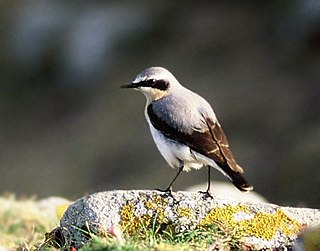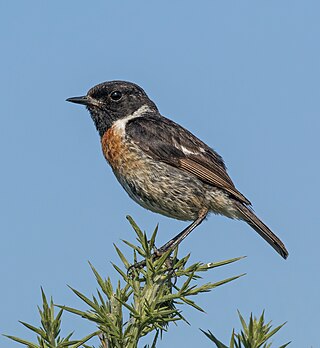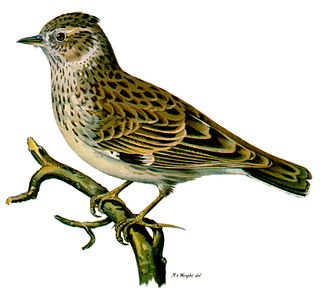
The Neogene is a geologic period and system that spans 20.45 million years from the end of the Paleogene Period 23.04 million years ago (Mya) to the beginning of the present Quaternary Period 2.58 million years ago. It is the second period of the Cenozoic and the eleventh period of the Phanerozoic. The Neogene is sub-divided into two epochs, the earlier Miocene and the later Pliocene. Some geologists assert that the Neogene cannot be clearly delineated from the modern geological period, the Quaternary. The term "Neogene" was coined in 1853 by the Austrian palaeontologist Moritz Hörnes (1815–1868). The earlier term Tertiary Period was used to define the span of time now covered by Paleogene and Neogene and, despite no longer being recognized as a formal stratigraphic term, "Tertiary" still sometimes remains in informal use.

The wheatears are passerine birds of the genus Oenanthe. They were formerly considered to be members of the thrush family, Turdidae, but are now more commonly placed in the flycatcher family, Muscicapidae. This is an Old World group, but the northern wheatear has established a foothold in eastern Canada and Greenland and in western Canada and Alaska.

The isabelline wheatear is a small passerine bird that was formerly classed as a member of the thrush family Turdidae, but is now more generally considered to be an Old World flycatcher in the family Muscicapidae. It is a migratory insectivorous bird. Its habitat is steppe and open countryside and it breeds in southern Russia and Central Asia to northern Pakistan, wintering in Africa and northwestern India. It is a very rare vagrant to western Europe.

The northern wheatear or wheatear is a small passerine bird that was formerly classed as a member of the thrush family Turdidae, but is now more generally considered to be an Old World flycatcher, Muscicapidae. It is the most widespread member of the wheatear genus Oenanthe in Europe and North and Central Asia.

Oenanthe, known as water dropworts, oenanthes, water parsleys, and water celeries, are a genus of plants in the family Apiaceae. Most of the species grow in damp ground, such as in marshes or in water.

Saxicola, the stonechats or chats, is a genus of 15 species of small passerine birds restricted to the Old World. They are insectivores occurring in open scrubland and grassland with scattered small shrubs.

Lullula is the genus of woodlarks, songbirds in the family Alaudidae. There is only one remaining extant species, the woodlark which is found in Europe, the mountains of northern Africa, the Middle East and western Asia. The remainder are known only from the fossil record.
The Serravallian is, in the geologic timescale, an age or a stage in the middle Miocene Epoch/Series, which spans the time between 13.82 Ma and 11.63 Ma. The Serravallian follows the Langhian and is followed by the Tortonian.

The Rio Mayo titi monkey is a species of titi monkey, a type of New World monkey, endemic to Peru. The Rio Mayo titi, was thought previously to have a small range of origin in the Alto Mayo valley, but research has proven that the range extends southward and reaches the Huayamba River, as well as Bajo Mayo. It had been classified as vulnerable but due to major habitat loss and restricted living space, it is now classified as Critically Endangered. In October 2012, it was included in The World's 25 Most Endangered Primates list. An increase in deforestation is leading to the decrease in available living space for this titi monkey, forcing it to live in sympatry with another species of Callicebus. Yet in some areas, such drastic deforestation has resulted in extremely high population density. The Rio Mayo titi is better adapted to moderately populated areas, thus overpopulation negatively impacts the species. The forests the Rio Mayo titi lives in are being destroyed for agricultural purposes, leaving little forest for the monkeys. They were only seen a few times and featured in museums until 2003 when more research was done on them. In order for this species to survive, their forests need to be protected to avoid overpopulation. Different conservation groups are working to help P. oenanthe survive. Neotropical Primate Conservation, Proyecto Mono Tocón and Amazónicos para la Amazonia are working in the more southern areas to protect the monkey. The Rio Mayo titi is a fairly inconspicuous creature, making observation and research difficult to obtain. Therefore, the traditional use of transect observation to monitor the monkey's population, is less effective. Instead, other methods of calculating the titi monkey's density in certain areas have been taken, such as research into the species-specific calls endemic to a certain area.

Luscinia is a genus of smallish passerine birds, containing the nightingales and relatives. Formerly classed as members of the thrush family Turdidae, they are now considered to be Old World flycatchers (Muscicapidae) of the chat subfamily (Saxicolinae). The chats are a lineage of Old World flycatchers that has evolved convergently to thrushes.

The Cyrillaceae are a small family of flowering plants in the order Ericales, native to warm temperate to tropical regions of the Americas. The family comprises two genera, Cliftonia and Cyrilla, each containing a single species, Cliftonia monophylla and Cyrilla racemiflora. However, additional species of Cyrilla are now often recognized and the genus is in need of taxonomic revision.

Oenanthotoxin is a toxin extracted from hemlock water-dropwort and other plants of the genus Oenanthe. It is a central nervous system poison, and acts as a noncompetitive antagonist of the neurotransmitter gamma-aminobutyric acid. A case has been made for the presence of this toxin in local Oenanthe species playing a causative role in euthanasia in ancient Sardinia. It was crystallized in 1949 by Clarke and co-workers. It is structurally closely related to the toxins cicutoxin and carotatoxin. Oenanthotoxin is a C17 polyacetylene isomer of cicutoxin.

Oenanthe javanica, commonly Java waterdropwort, water celery, water dropwort, Chinese celery, Indian pennywort, minari and Japanese parsley, is a plant of the genus Oenanthe originating from East Asia. It has a widespread native distribution in temperate Asia and tropical Asia, and is also native to Queensland, Australia.
Praepusa is an extinct genus of earless seals from Neogene marine deposits in Europe. Five species, P. boeska,P. magyaricus, P. pannonica, P. tarchankutica and P. vindoboensis, are known.
The geology of Romania is structurally complex, with evidence of past crustal movements and the incorporation of different blocks or platforms to the edge of Europe, driving recent mountain building of the Carpathian Mountains. Romania is a country located at the crossroads of Central, Eastern, and Southeastern Europe. It borders the Black Sea to the southeast, Bulgaria to the south, Ukraine to the north, Hungary to the west, Serbia to the southwest, and Moldova to the east.
Calandrella gali is an extinct species of Calandrella that inhabited Hungary during the Neogene period.
Phylloscopus pliocaenicus is an extinct species of Phylloscopus that inhabited Hungary during the Neogene period.
Emberiza pannonica is an extinct species of Emberiza that inhabited Hungary during the Neogene period.
Muscicapa petenyii is an extinct species of Old World flycatcher: a passerine bird in the genus Muscicapa that inhabited Hungary during the Neogene period.
Oenanthe kormosi is an extinct species of Oenanthe that inhabited Hungary during the Neogene period.











